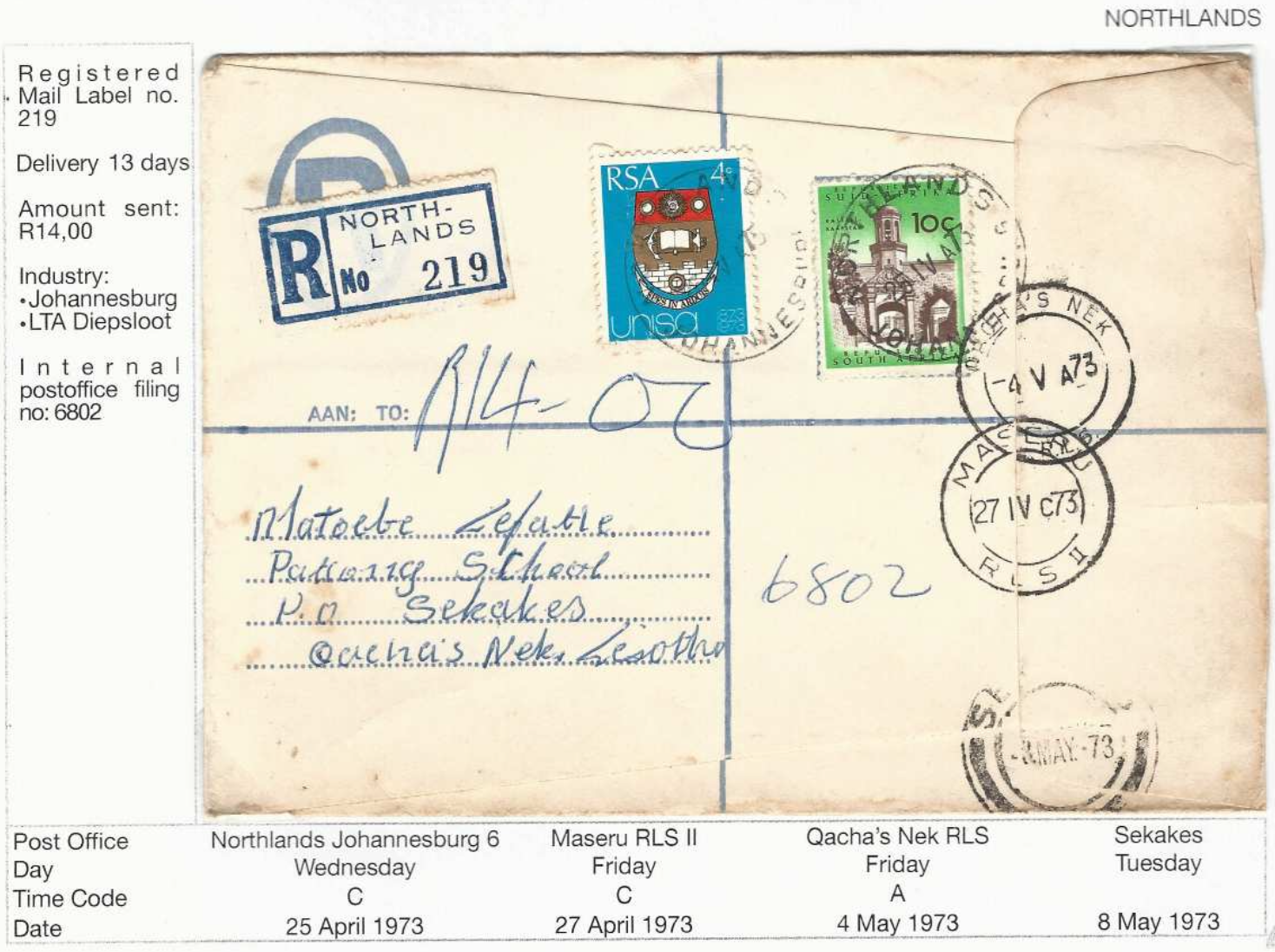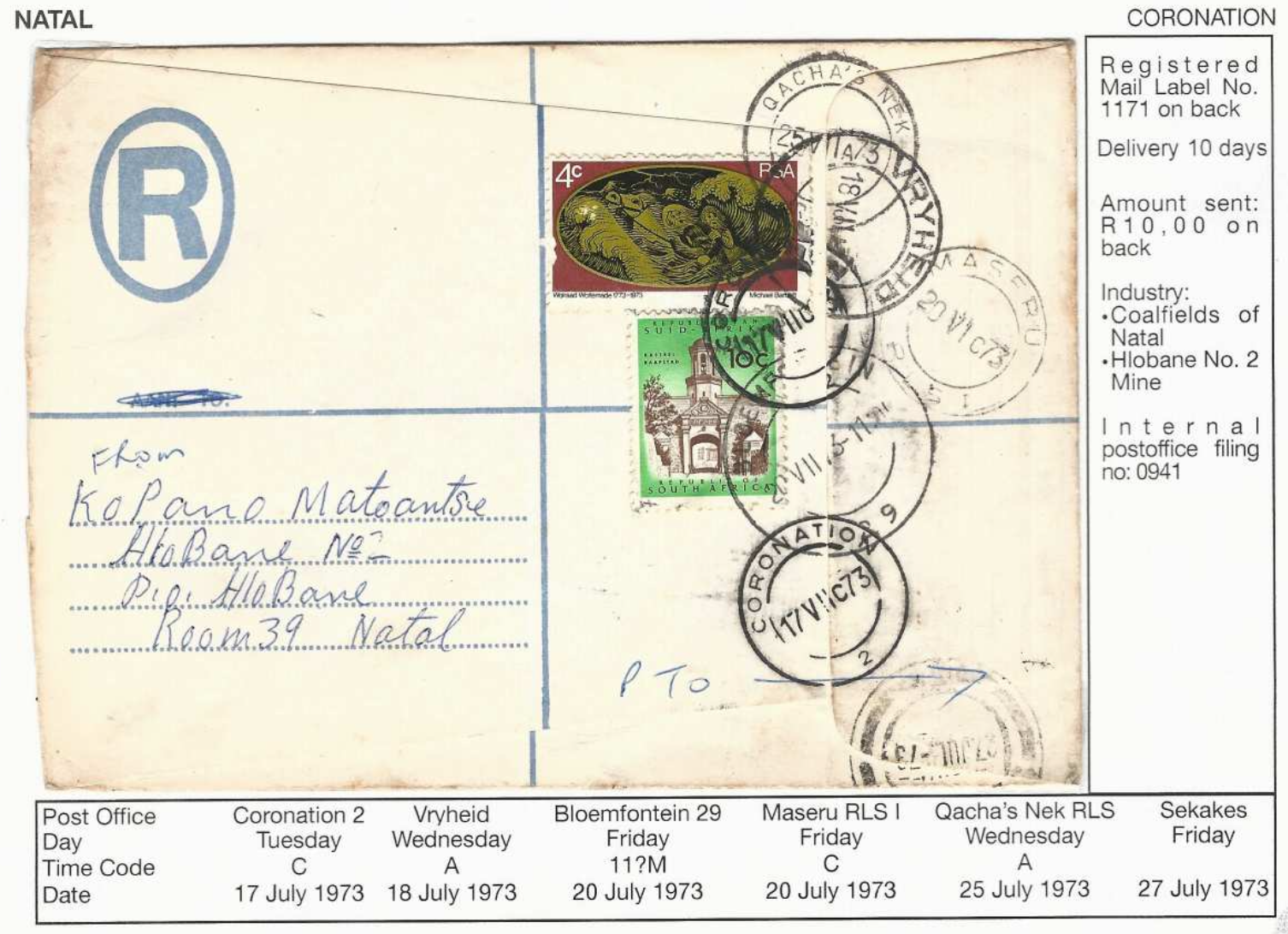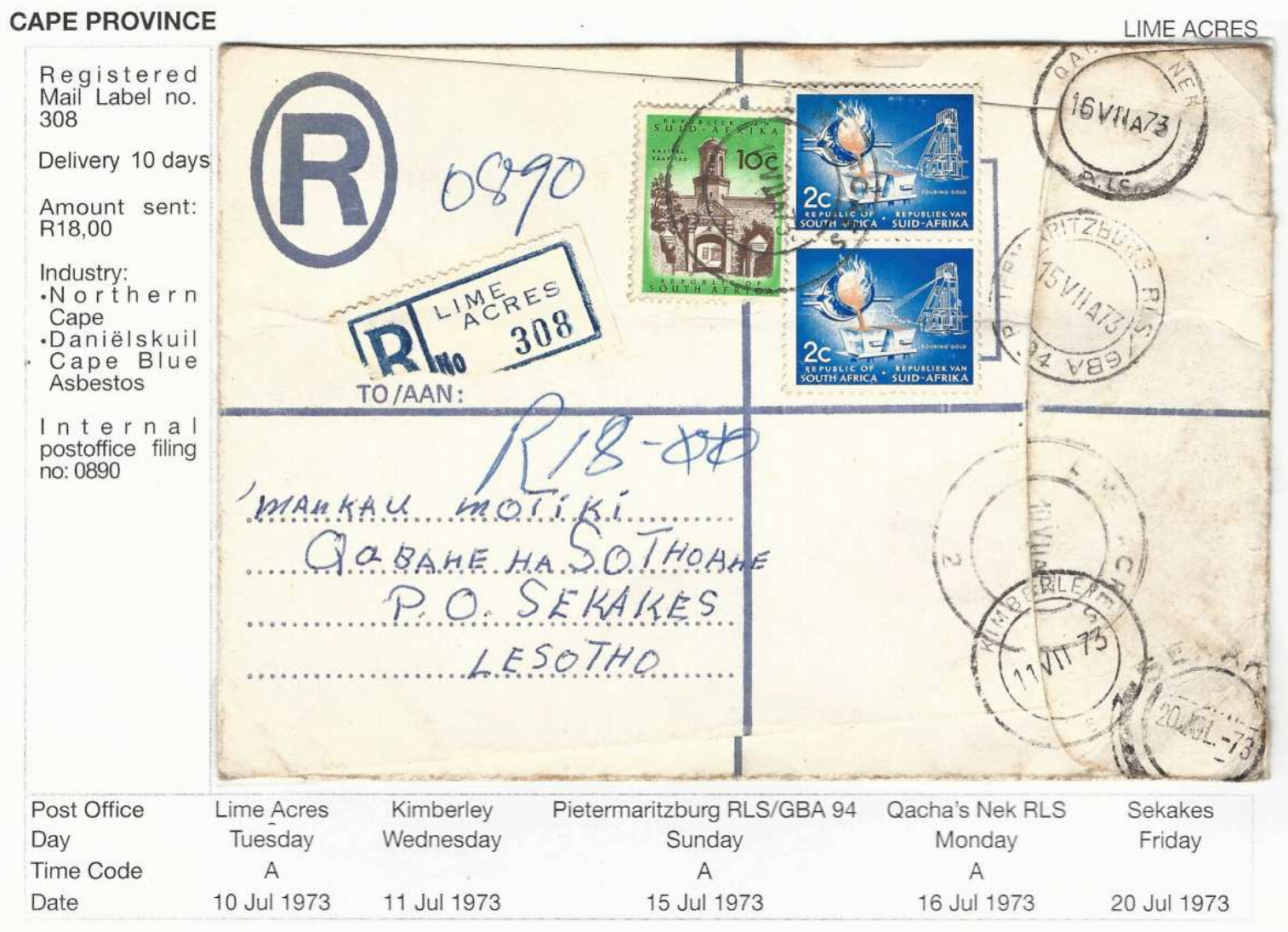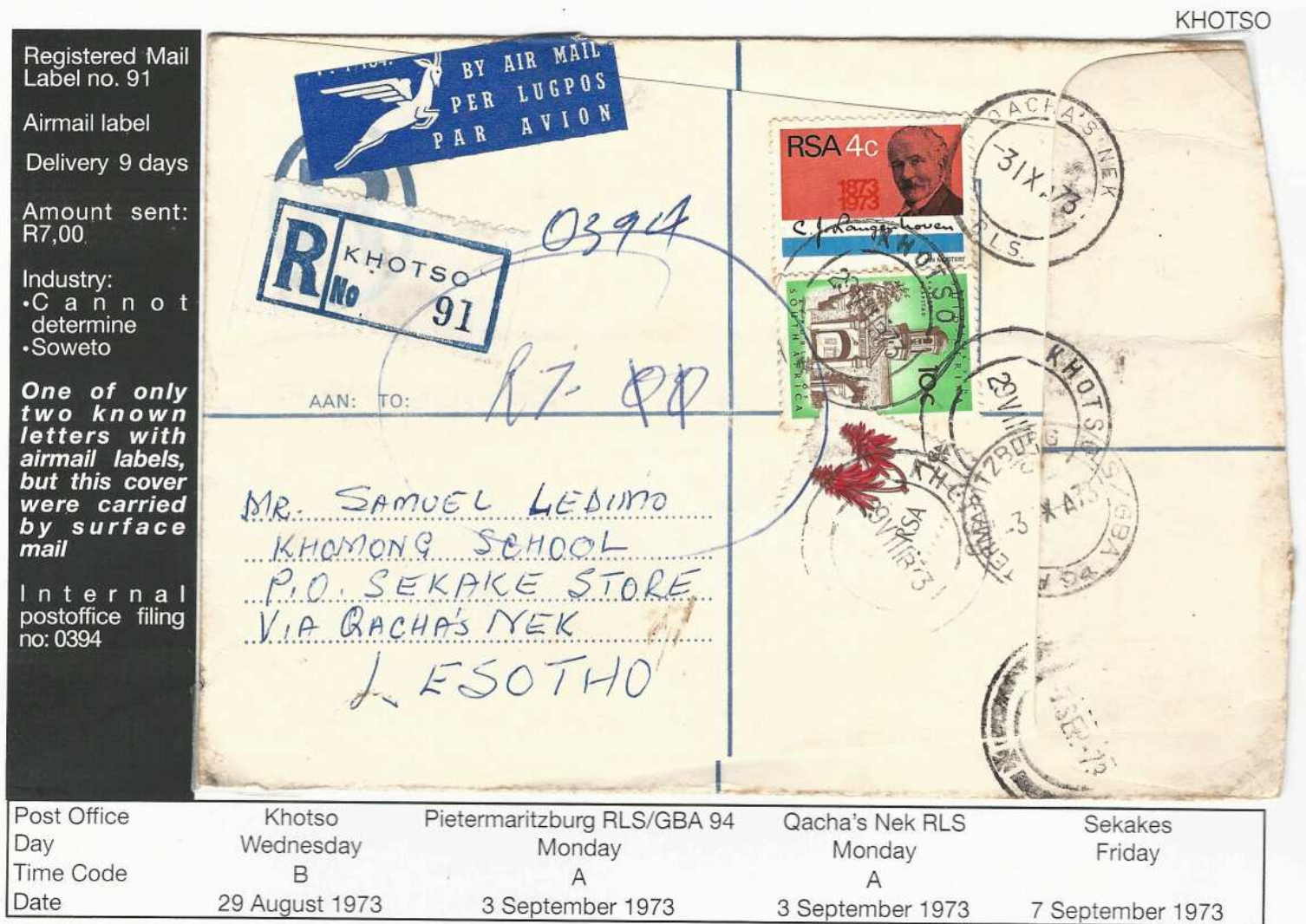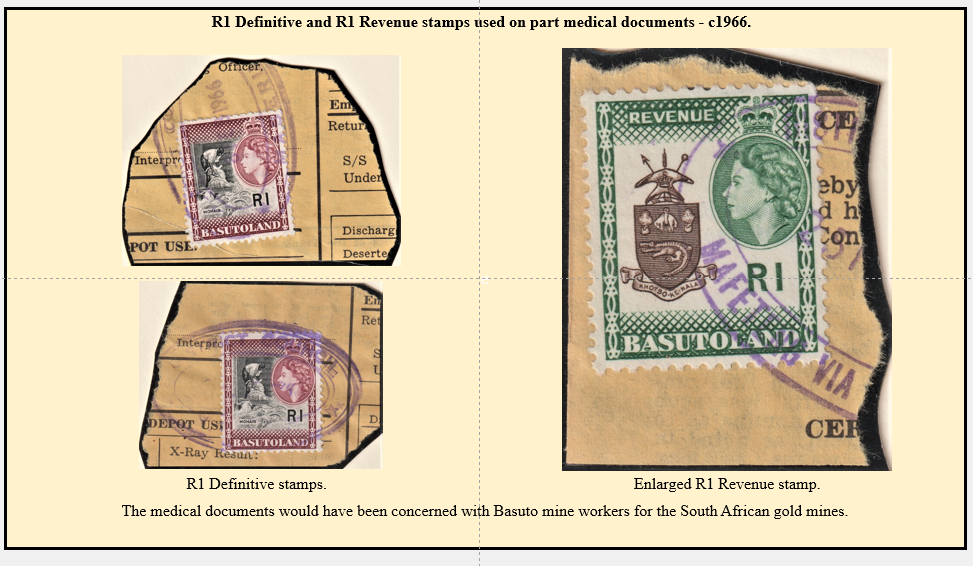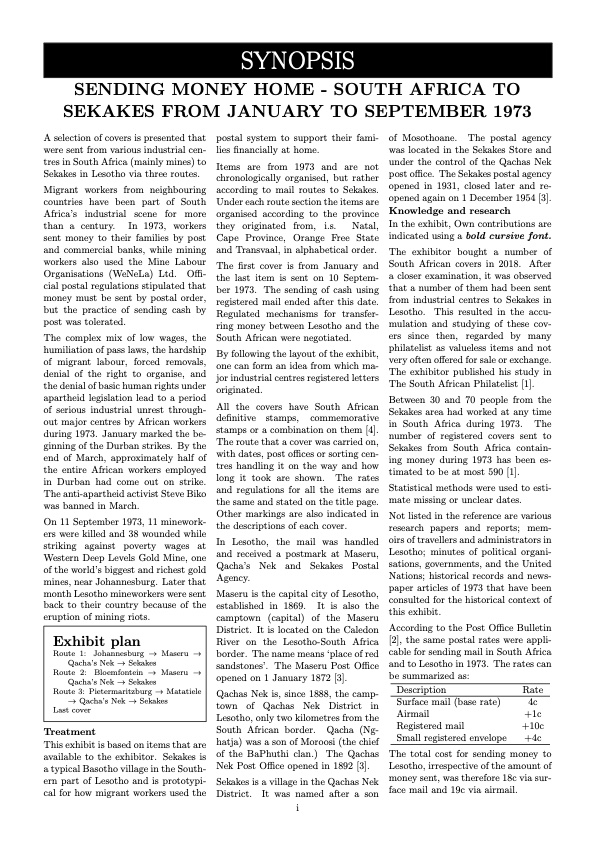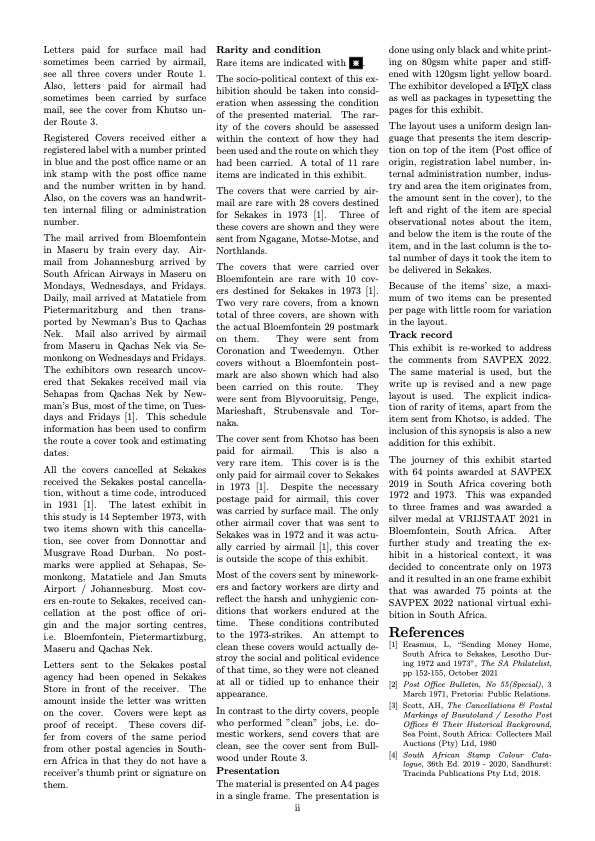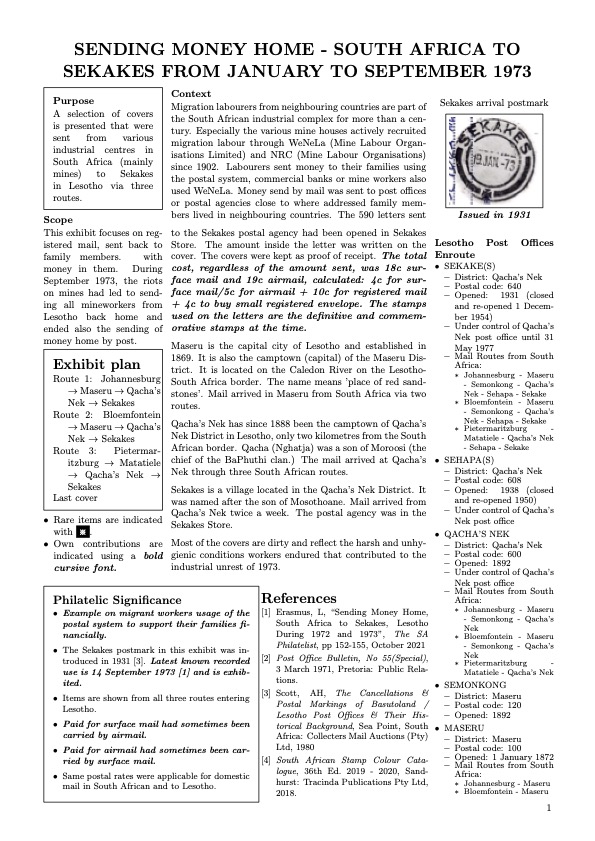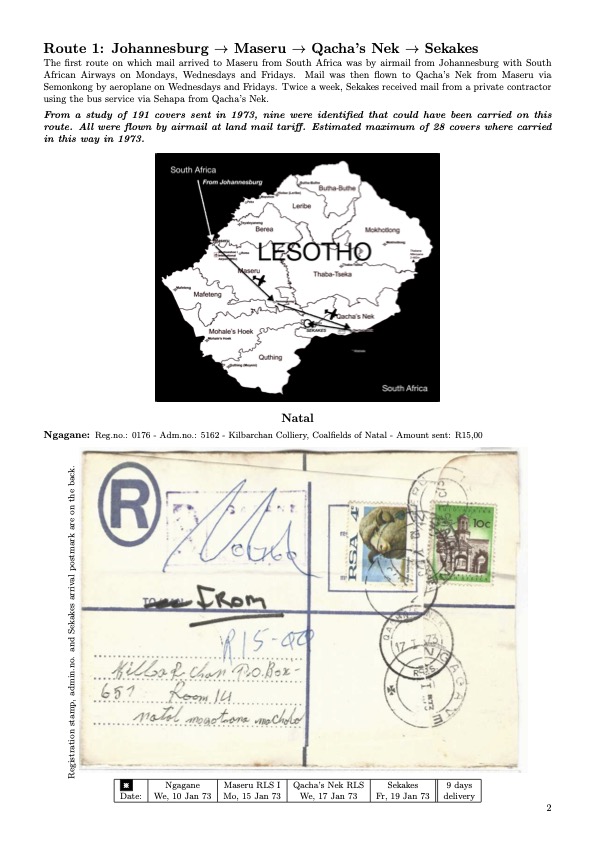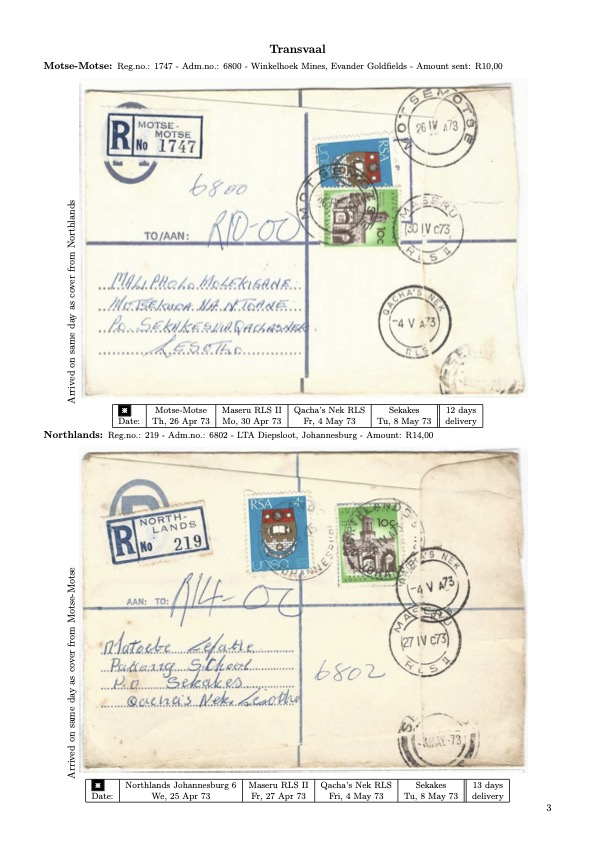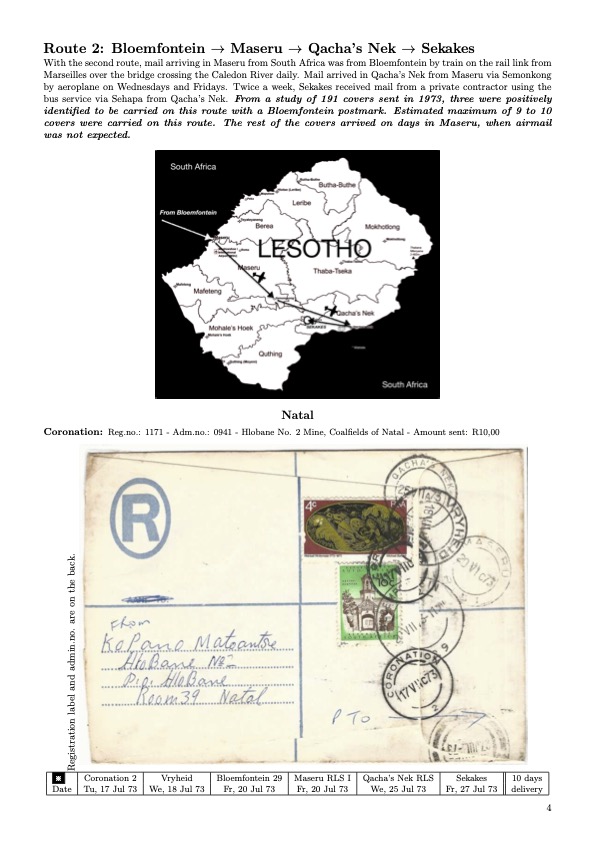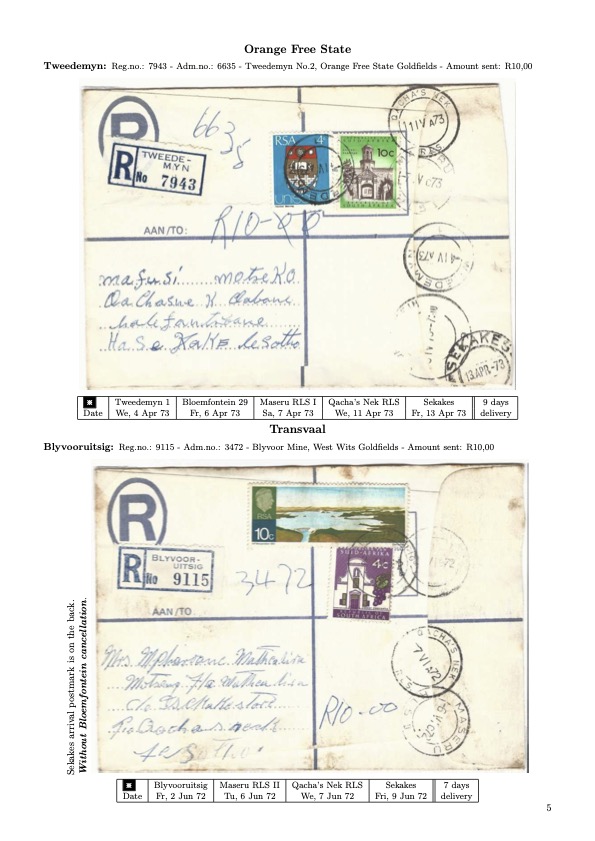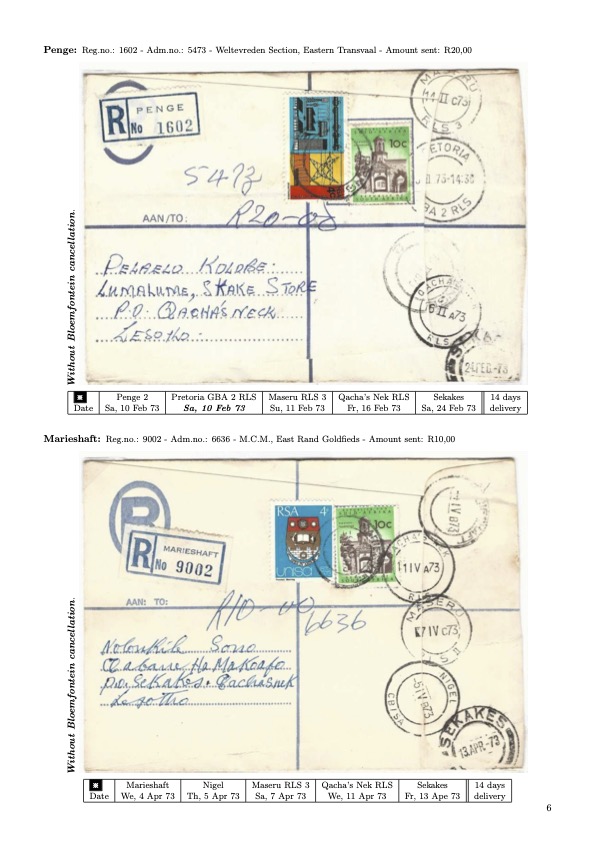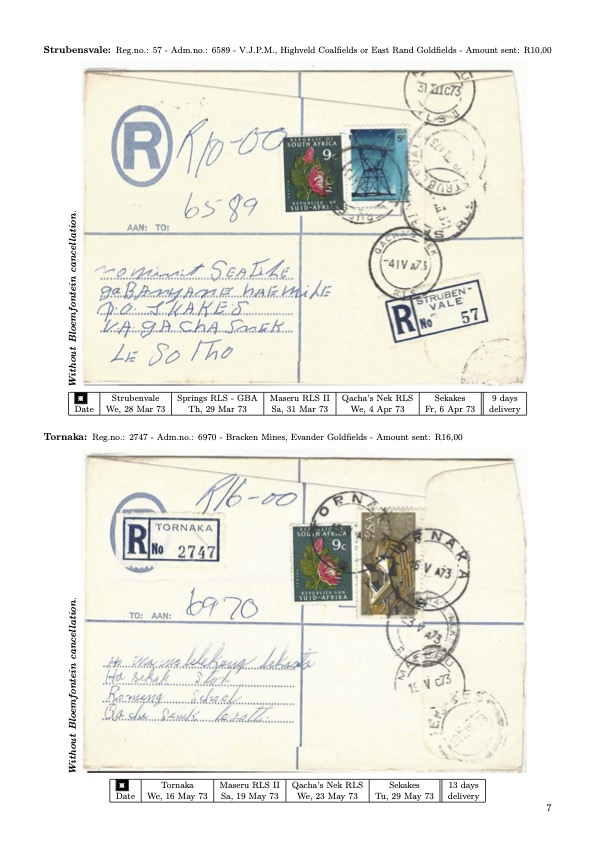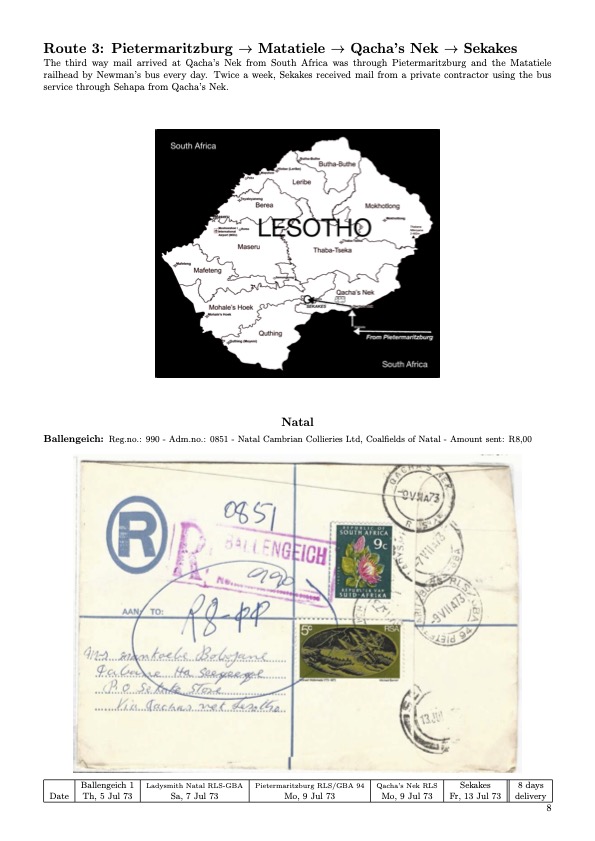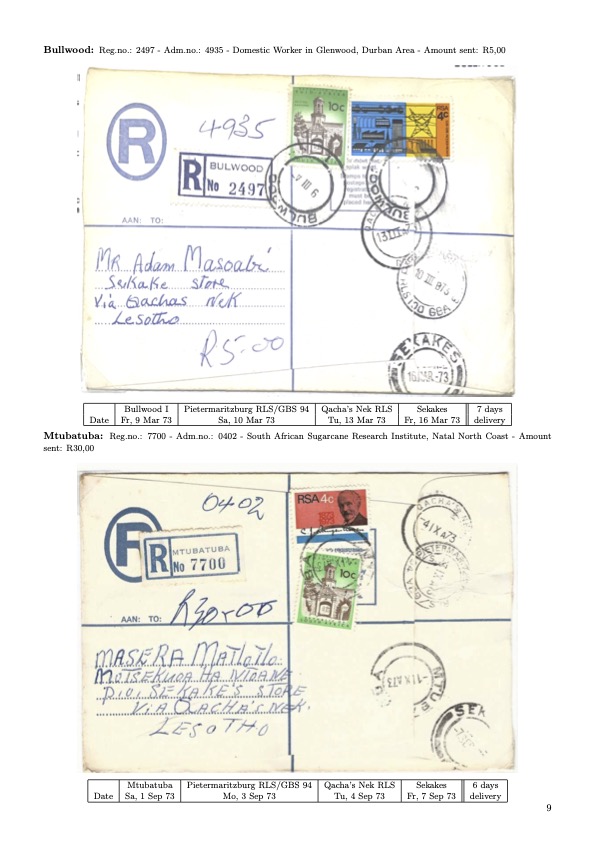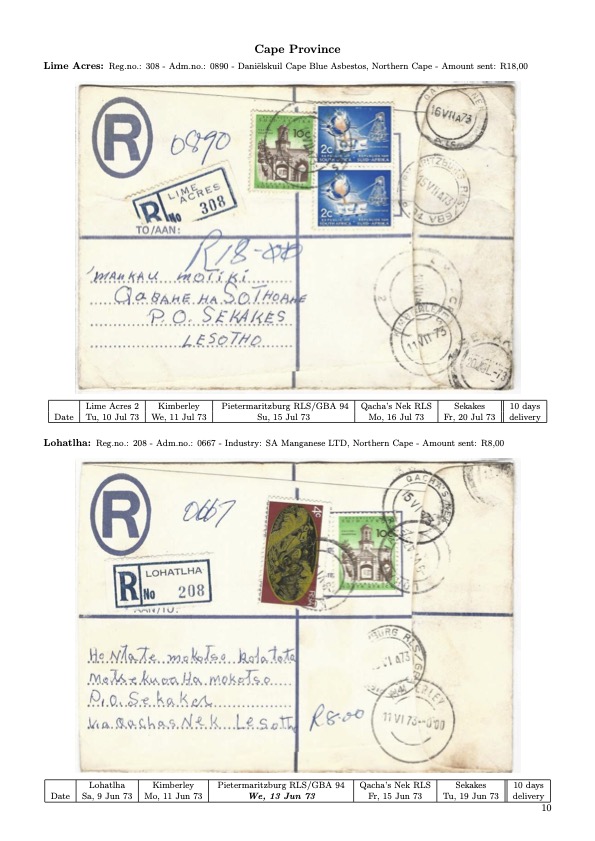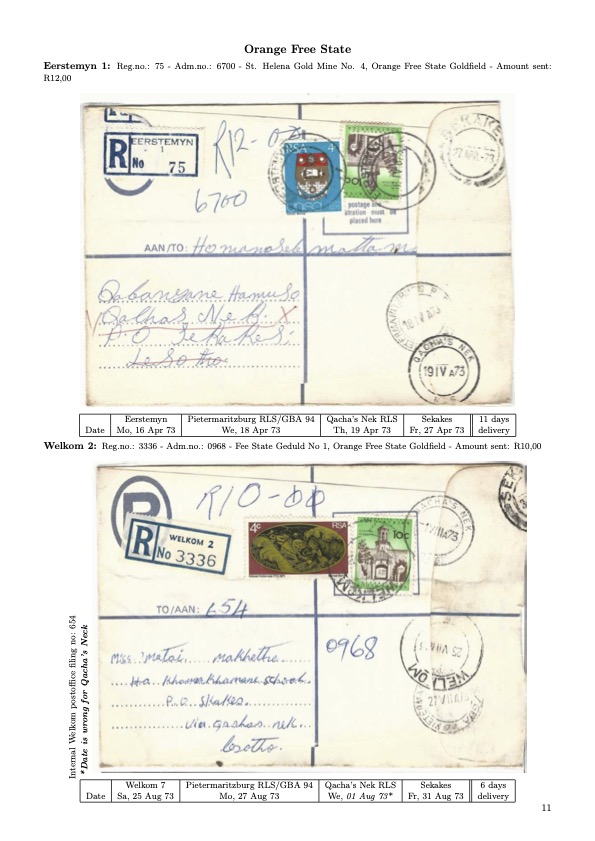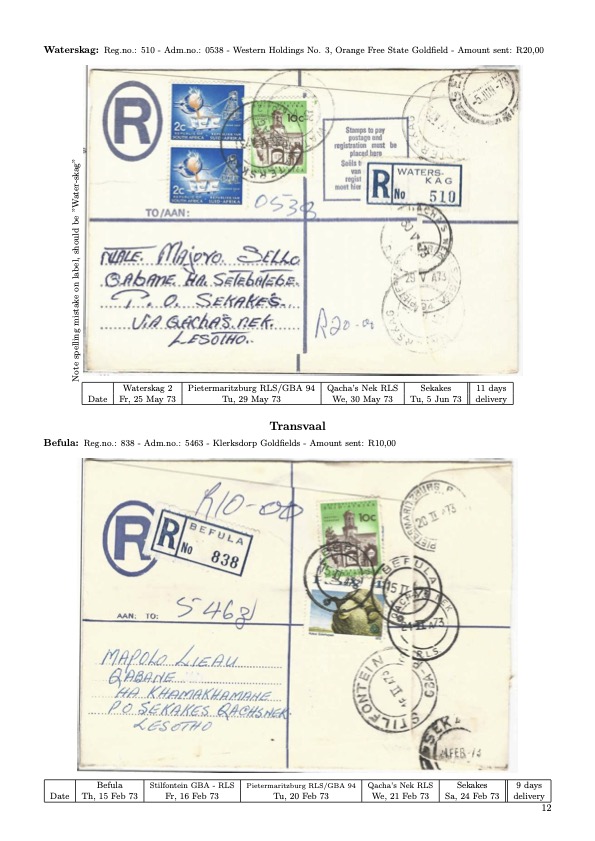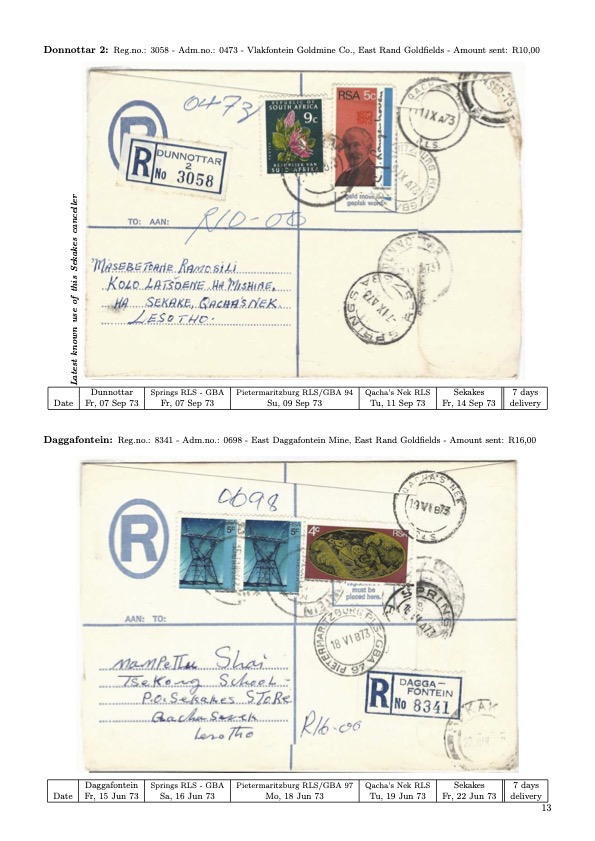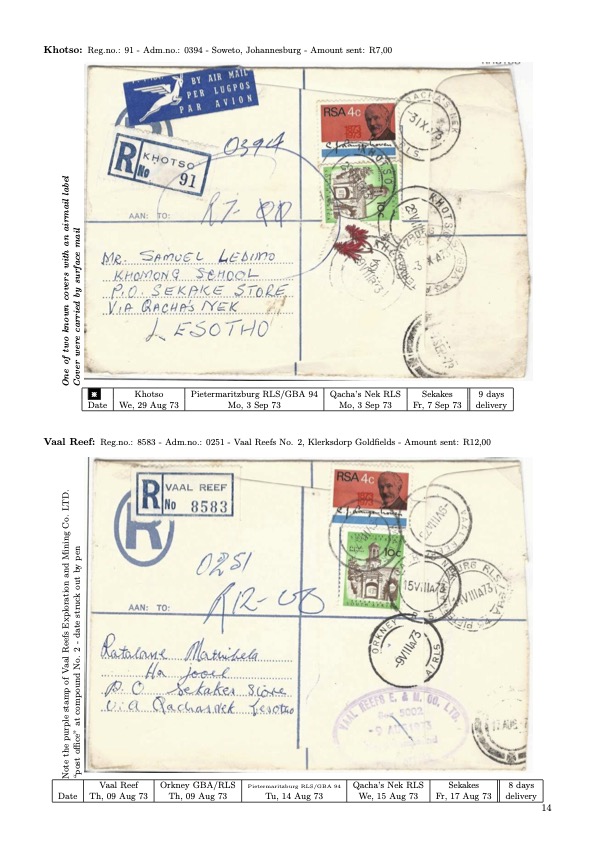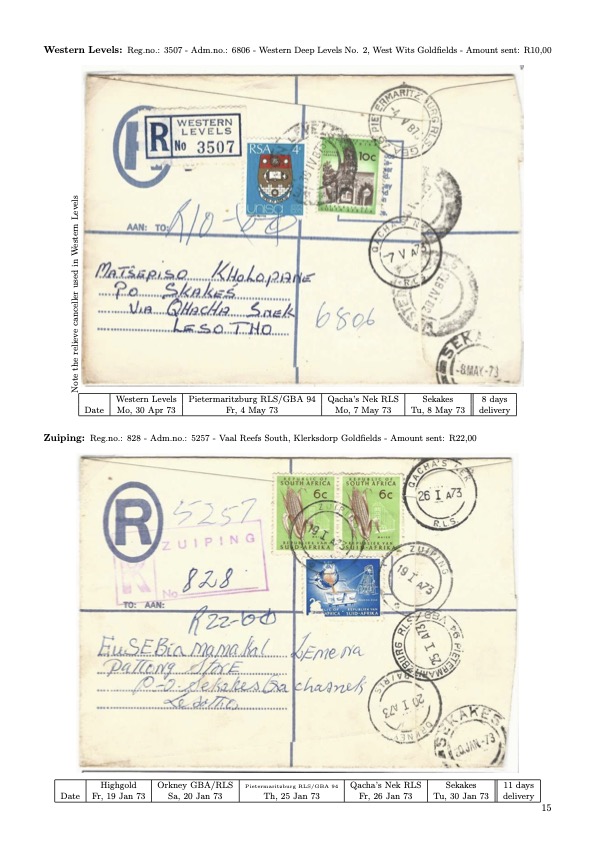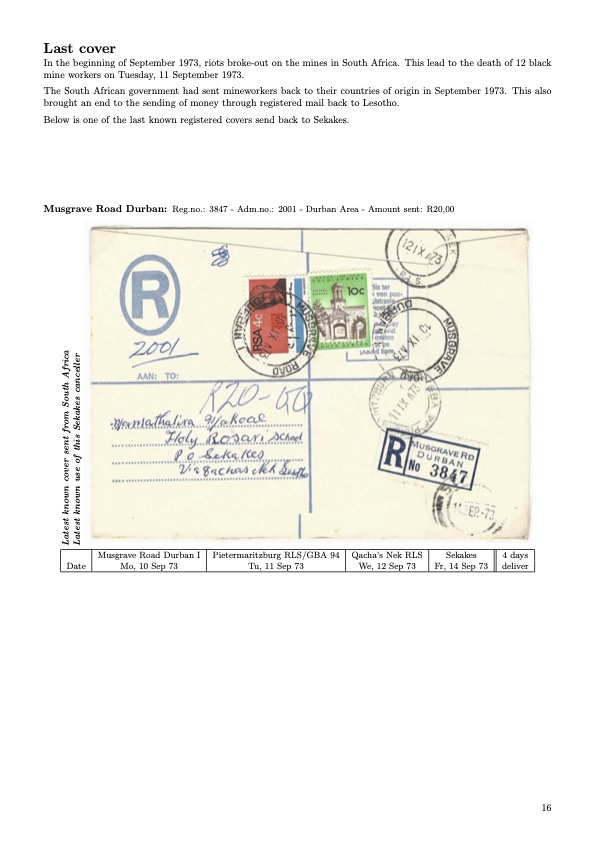Registered Mail from South Africa to Sekakes, Lesotho
Quote from louwrence on June 10, 2022, 12:11 pmMigration labourers from neighbouring countries are part of the South African industrial complex for more than a century. Especially the various mine houses actively recruited migration labour through WeNeLa (Mine Labour Organisations Limited) and NRC (Mine Labour Organisations) since 1902. Labourers sent money to their families using the postal system, commercial banks or mine workers also used WeNeLa. Money send by mail was sent to post offices or postal agencies close to where addressed family members lived in neighbouring countries.
Letters sent to the Sekakes postal agency had been opened in Sekakes Store. The amount inside the letter was written on the cover. The covers were kept as proof of receipt. The total cost, regardless of the amount sent, was 18c surface mail and 19c airmail, calculated: 4c for surface mail/5c for airmail + 10c for registered mail + 4c to buy small registered envelope. The stamps used on the letters are the definitive and commemorative stamps at the time.
During September 1973 the riots on mines had led to sending all mineworkers from Lesotho back home and the sending of money with registered mail ended.
Most of the covers sent by mineworkers and factory workers are dirty and reflect the harsh and unhygienic conditions that workers endured in 1973. These conditions contributed to the September 1973 mining strikes. An attempt to clean these covers, as is the practice in philately to enhance appearance, would destroy the social and political evidence of that time, so they were not cleaned at all in my collection.
Mail Routes from South Africa:
1. Johannesburg - Maseru - Semonkong - Qacha’s Nek - Sehapas - Sekakes
2. Bloemfontein - Maseru - Semonkong - Qacha’s Nek - Sehapas - Sekakes
3. Matatiele - Qacha’s Nek - Sehapas - SekakesFor more information see: Erasmus, L, “Sending Money Home, South Africa to Sekakes, Lesotho During 1972 and 1973”, The SA Philatelist, pp 152-155, October 2021
Migration labourers from neighbouring countries are part of the South African industrial complex for more than a century. Especially the various mine houses actively recruited migration labour through WeNeLa (Mine Labour Organisations Limited) and NRC (Mine Labour Organisations) since 1902. Labourers sent money to their families using the postal system, commercial banks or mine workers also used WeNeLa. Money send by mail was sent to post offices or postal agencies close to where addressed family members lived in neighbouring countries.
Letters sent to the Sekakes postal agency had been opened in Sekakes Store. The amount inside the letter was written on the cover. The covers were kept as proof of receipt. The total cost, regardless of the amount sent, was 18c surface mail and 19c airmail, calculated: 4c for surface mail/5c for airmail + 10c for registered mail + 4c to buy small registered envelope. The stamps used on the letters are the definitive and commemorative stamps at the time.
During September 1973 the riots on mines had led to sending all mineworkers from Lesotho back home and the sending of money with registered mail ended.
Most of the covers sent by mineworkers and factory workers are dirty and reflect the harsh and unhygienic conditions that workers endured in 1973. These conditions contributed to the September 1973 mining strikes. An attempt to clean these covers, as is the practice in philately to enhance appearance, would destroy the social and political evidence of that time, so they were not cleaned at all in my collection.
Mail Routes from South Africa:
1. Johannesburg - Maseru - Semonkong - Qacha’s Nek - Sehapas - Sekakes
2. Bloemfontein - Maseru - Semonkong - Qacha’s Nek - Sehapas - Sekakes
3. Matatiele - Qacha’s Nek - Sehapas - Sekakes
For more information see: Erasmus, L, “Sending Money Home, South Africa to Sekakes, Lesotho During 1972 and 1973”, The SA Philatelist, pp 152-155, October 2021
Quote from Jamie Smith on June 10, 2022, 12:32 pmWonderful documents of the Basutoland social and postal history of the period. I try to specialise in this area but have not seen or even heard of this facet of postal history. I do have RI definitive and revenue stamps on piece which have been torn of medical documents from when prospective miners had their medical, but no full documnts. If anyone has a full document I would appreciate a scan or even a spare!! Here is to hoping that more posts come in!
Wonderful documents of the Basutoland social and postal history of the period. I try to specialise in this area but have not seen or even heard of this facet of postal history. I do have RI definitive and revenue stamps on piece which have been torn of medical documents from when prospective miners had their medical, but no full documnts. If anyone has a full document I would appreciate a scan or even a spare!! Here is to hoping that more posts come in!
Uploaded files:Quote from Steve on June 10, 2022, 1:56 pmGreat! At last, some real modern South African postal history with a social context. Well done, Louwrence.
I appreciate your honesty in stating that these 'dirty' covers 'reflect the harsh and unhygienic conditions that workers endured in 1973'. Thank you so much for making the South African Philately Club more meaningful to more people, especially Black South Africans who can see through them the lives and spirt of their ancestors as they worked to feed their distant families, struggling to survive and make a New South Africa.
Generally, I do not like the post 1961-Republican era nor do I like dirty covers. However, you are right not to clean them. You cannot do justice to the lives of Black workers by sanitising these items simply to satify the aesthetics of the affluent philatelic classes who largely sailed uncomplainingly and in comfort through the Apartheid era. If one is to make a relevant postal history display on South Africa and or Apartheid in the 1970s, 'dirty' covers like these are needed to show the reality of lives lived in a compound, location, homeland or tiny outside domestic servants room.
Great! At last, some real modern South African postal history with a social context. Well done, Louwrence.
I appreciate your honesty in stating that these 'dirty' covers 'reflect the harsh and unhygienic conditions that workers endured in 1973'. Thank you so much for making the South African Philately Club more meaningful to more people, especially Black South Africans who can see through them the lives and spirt of their ancestors as they worked to feed their distant families, struggling to survive and make a New South Africa.
Generally, I do not like the post 1961-Republican era nor do I like dirty covers. However, you are right not to clean them. You cannot do justice to the lives of Black workers by sanitising these items simply to satify the aesthetics of the affluent philatelic classes who largely sailed uncomplainingly and in comfort through the Apartheid era. If one is to make a relevant postal history display on South Africa and or Apartheid in the 1970s, 'dirty' covers like these are needed to show the reality of lives lived in a compound, location, homeland or tiny outside domestic servants room.
Quote from pthy@ucdavis.edu on July 1, 2022, 11:04 amThis is really some interesting covers. But as all interesting covers - there is also some unanswered questions.
- Who mailed the letters or wrote the address? Did a miners 'support' organization help or mail them? I have seen several covers mailed home to Basutoland in the 40's. This is not the writing style of an illiterate native worker (or for my covers - soldier).
- Who wrote the amount enclosed? Was this written when received at PO or local administration office? Again unlikely to have been the mineworker since the writing style are pretty similar for all covers (and would also have been a security risk). I have seen registered covers mailed from Bechuanaland to SA to order various stuff. They have the value enclosed written on front at arrival at the recipient.
- How was the money transferred? Was it as postal orders (SA orders) or as banknotes? Or other means? The recipient would certainly have been able to use banknotes and also postal orders provided a post office/agency nearby. But anything else like bank transfers would probably have been difficult.
- It was probably permitted to mail postal orders as long as the letter was registered. Was it possible to mail banknotes in registered envelopes? - but what about banknotes would they not required insurance
- Again quite an interesting subject and thanks for posting them.
This is really some interesting covers. But as all interesting covers - there is also some unanswered questions.
- Who mailed the letters or wrote the address? Did a miners 'support' organization help or mail them? I have seen several covers mailed home to Basutoland in the 40's. This is not the writing style of an illiterate native worker (or for my covers - soldier).
- Who wrote the amount enclosed? Was this written when received at PO or local administration office? Again unlikely to have been the mineworker since the writing style are pretty similar for all covers (and would also have been a security risk). I have seen registered covers mailed from Bechuanaland to SA to order various stuff. They have the value enclosed written on front at arrival at the recipient.
- How was the money transferred? Was it as postal orders (SA orders) or as banknotes? Or other means? The recipient would certainly have been able to use banknotes and also postal orders provided a post office/agency nearby. But anything else like bank transfers would probably have been difficult.
- It was probably permitted to mail postal orders as long as the letter was registered. Was it possible to mail banknotes in registered envelopes? - but what about banknotes would they not required insurance
- Again quite an interesting subject and thanks for posting them.
Quote from louwrence on January 3, 2023, 3:44 pm
- The mine workers wrote the addresses themselves on the covers. Lesotho had at the time and even today, one of the highest literacy rates in Africa. In my study of 266 covers, some handwriting and spelling of words looked like that of illiterate persons.
- As I have mentioned, the Sekakes Postal Agency wrote it onto the cover on opening and kept the covers as receipts. A general practice in those days in Southern Africa. The difference at Sekakes is there are no thumb prints of the reveiver on the covers like in South African cases.
- Although not allowed per regulation, money was send using bank notes and coins from South Africa to Lesotho. This changed after September 1973, after an intergovernmental agreement between South Africa and Lesotho.
- See 3. No evidence of insurance have been found examining 266 covers send from South Africa to Sekakes.
- Thanks
- The mine workers wrote the addresses themselves on the covers. Lesotho had at the time and even today, one of the highest literacy rates in Africa. In my study of 266 covers, some handwriting and spelling of words looked like that of illiterate persons.
- As I have mentioned, the Sekakes Postal Agency wrote it onto the cover on opening and kept the covers as receipts. A general practice in those days in Southern Africa. The difference at Sekakes is there are no thumb prints of the reveiver on the covers like in South African cases.
- Although not allowed per regulation, money was send using bank notes and coins from South Africa to Lesotho. This changed after September 1973, after an intergovernmental agreement between South Africa and Lesotho.
- See 3. No evidence of insurance have been found examining 266 covers send from South Africa to Sekakes.
- Thanks
Quote from louwrence on January 3, 2023, 6:38 pmSENDING MONEY HOME - SOUTH AFRICA TO SEKAKES FROM JANUARY TO SEPTEMBER 1973 (part 1):
:
SENDING MONEY HOME - SOUTH AFRICA TO SEKAKES FROM JANUARY TO SEPTEMBER 1973 (part 1):
:
Uploaded files:Quote from louwrence on January 3, 2023, 6:40 pmSENDING MONEY HOME - SOUTH AFRICA TO SEKAKES FROM JANUARY TO SEPTEMBER 1973 (part 2):
SENDING MONEY HOME - SOUTH AFRICA TO SEKAKES FROM JANUARY TO SEPTEMBER 1973 (part 2):
Quote from louwrence on January 3, 2023, 6:41 pmSENDING MONEY HOME - SOUTH AFRICA TO SEKAKES FROM JANUARY TO SEPTEMBER 1973 (part 3):
SENDING MONEY HOME - SOUTH AFRICA TO SEKAKES FROM JANUARY TO SEPTEMBER 1973 (part 3):
Uploaded files:Quote from louwrence on January 3, 2023, 6:42 pmSENDING MONEY HOME - SOUTH AFRICA TO SEKAKES FROM JANUARY TO SEPTEMBER 1973 (part 4):
SENDING MONEY HOME - SOUTH AFRICA TO SEKAKES FROM JANUARY TO SEPTEMBER 1973 (part 4):
Uploaded files:
